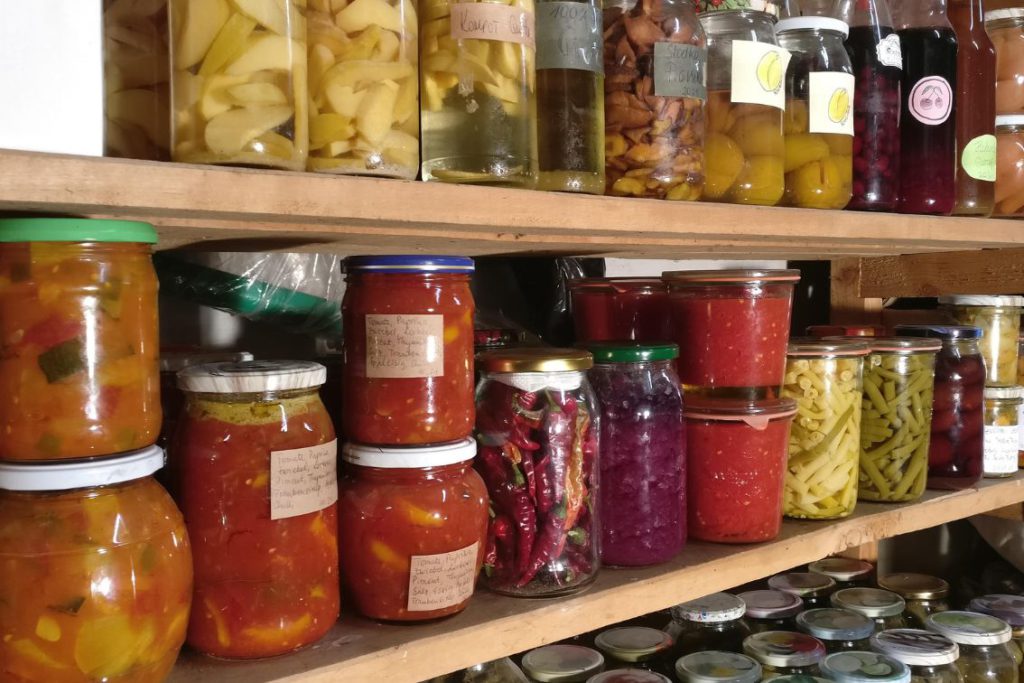Welcome to Homesteading For Women – we hope you enjoy all our tips and tricks for homestead women! Please note that we use affiliate links and ads to generate income at no cost to you.
When I first started simplifying our meals and getting back to basics, one of the most helpful things I did was start a real pantry. Not a Pinterest-perfect walk-in with labels on everything (though that does sound nice), but a simple, practical farmhouse pantry with the ingredients I use all the time. If you’re looking to cook more from scratch, save money, or just feel a little more prepared, here’s a look at what I keep stocked—and how I built it up a little at a time.
A Pantry That Grew With Me
When we first moved out to the country, I had one little cabinet for dry goods and a single shelf in the hall closet where I’d stash flour and rice in old coffee cans. I didn’t have a fancy setup, but I made it work. Over time, I started noticing which meals we made over and over—and those became the building blocks of my pantry. It didn’t happen overnight, but before I knew it, I had a solid stash of ingredients I could count on.
1. The Baking Basics
These are the pantry staples I always want to have on hand. They’re used in everything from biscuits to homemade bread.
- All-purpose flour
- Whole wheat flour
- Sugar and brown sugar
- Honey or maple syrup
- Salt (regular and canning)
- Baking powder
- Baking soda
- Active dry yeast
- Cornstarch
- Cocoa powder
I like to store mine in glass jars or big plastic containers with scoopable lids—keeps the bugs out and makes it easy to see when I’m running low.

2. Canned and Preserved Goods
Whether you can your own or grab a few extras from the store, these are lifesavers when you want to make a meal fast.
- Canned tomatoes (whole, diced, paste)
- Green beans, corn, carrots
- Beans: black, pinto, navy
- Tuna or canned chicken
- Soups or broth
- Homemade jams, pickles, and relishes
If you’ve been learning to can, now’s a great time to rotate those jars and make use of what you’ve already preserved.
3. Grains and Pasta
A few different grains give me flexibility when planning meals, especially when I want to make something hearty and filling.
- Rice (white and brown)
- Oatmeal (old-fashioned or steel cut)
- Pasta (elbow, spaghetti, noodles)
- Cornmeal or grits
- Quinoa, barley, or other whole grains (optional)
I keep my oats in a clear container on the shelf because we use them almost daily.
4. Cooking Oils and Vinegars
A little goes a long way with these staples. I always try to have:
- Olive oil
- Vegetable oil or lard
- Apple cider vinegar
- White vinegar
- Balsamic or red wine vinegar (nice but not essential)
Vinegar also comes in handy for cleaning and homemade dressings.
5. Herbs, Spices, and Seasonings
Even basic meals taste better with the right seasonings. I usually keep:
- Garlic powder, onion powder
- Salt and pepper
- Chili powder, paprika
- Oregano, thyme, basil
- Cinnamon and nutmeg
- Bouillon cubes or Better Than Bouillon
- Soy sauce and Worcestershire
A little rotating spice rack by the stove helps me grab what I need quickly.
6. Treats, Drinks, and Comfort Foods
Because sometimes you just need something easy or a little sweet.
- Coffee and tea
- Hot chocolate mix
- Shelf-stable milk or powdered milk
- Popcorn kernels
- Crackers or pretzels
- Instant pudding, Jell-O, or cookie mix
- Chocolate chips for baking (or snacking)
These aren’t must-haves, but they sure make life more fun.
7. My Backup Shelf
I keep a small shelf in the back of the pantry or hall closet for extras of things we go through quickly—like:
- Flour and sugar
- Pasta and rice
- Extra coffee or canned goods
- Water jugs
- Emergency items (batteries, candles, manual can opener)
Having just a little extra of your core ingredients makes it easier to ride out bad weather, busy weeks, or tight grocery budgets.
One Winter That Made Me Grateful
A few years ago we had a surprise snowstorm that knocked out the roads for a few days. I didn’t panic—I just pulled a few things from the pantry and threw together a big pot of soup with biscuits on the side. We stayed warm and well-fed without needing to leave the house. That’s the power of a good pantry. It isn’t just about being prepared—it’s about peace of mind.
Final Thoughts
A well-stocked pantry doesn’t have to be expensive or overwhelming. I built mine slowly—just adding a couple extra things each time I went to the store. And over time, it started to feel like a true backup plan that gives me peace of mind.
If you’re just getting started, print out a checklist or make a note of the meals you cook most often. Then build your pantry around those ingredients.
And if you’d like to make your shelves a little more organized and pretty, I’ve got a free printable set of Farmhouse Pantry Labels you can grab right here.
👉 [Link to your freebie]
You’ll be surprised how nice it feels to open your pantry and see everything ready to go.
- Caring for Aging Parents: What I’ve Learned the Hard Way (And Why I’m Planning Ahead Now) - August 4, 2025
- 7 Must Get Beginner Herbal Books For Your Library - July 30, 2025
- What to Have Ready When the Power Goes Out (Even at 6AM!) - July 27, 2025

